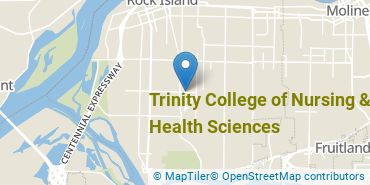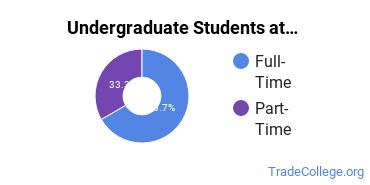Trinity College of Nursing & Health Sciences Trade Programs
Located in Rock Island, Illinois, Trinity College of Nursing & Health Sciences is a private not-for-profit institution. The location of Trinity College is great for students who prefer living in an urban area.
Featured schools near , edit
Where Is Trinity College of Nursing & Health Sciences?

Contact details for Trinity College are given below.
| Contact Details | |
|---|---|
| Address: | 2122 25Th Avenue, Rock Island, IL 61201-5317 |
| Phone: | 309-779-7700 |
| Website: | www.trinitycollegeqc.edu |
Can I Afford Trinity College?
| In State | Out of State | |
|---|---|---|
| Tuition | $24,707 | $24,707 |
| Fees | $3,318 | $3,318 |
Trinity College of Nursing & Health Sciences Undergraduate Student Diversity

There are also 28 graduate students at the school.
Gender Diversity
Of the 99 full-time undergraduates at Trinity College, 7% are male and 93% are female.

Racial-Ethnic Diversity
The racial-ethnic breakdown of Trinity College of Nursing & Health Sciences students is as follows.

| Race/Ethnicity | Number of Grads |
|---|---|
| Asian | 1 |
| Black or African American | 3 |
| Hispanic or Latino | 10 |
| White | 74 |
| International Students | 0 |
| Other Races/Ethnicities | 11 |
Trinity College of Nursing & Health Sciences Trade School Concentrations
The table below shows the number of awards for each concentration.
| Major | Associate’s | TOTAL |
|---|---|---|
| Radiologic Technology | 11 | 11 |
| TOTAL | 11 | 11 |
References
*The racial-ethnic minorities count is calculated by taking the total number of students and subtracting white students, international students, and students whose race/ethnicity was unknown. This number is then divided by the total number of students at the school to obtain the racial-ethnic minorities percentage.
- College Factual
- National Center for Education Statistics
- Image Credit: By Jayzl Nebre-Villafania under License
More about our data sources and methodologies.
Featured Schools
 Request Info
Request Info
|
Southern New Hampshire University You have goals. Southern New Hampshire University can help you get there. Whether you need a bachelor's degree to get into a career or want a master's degree to move up in your current career, SNHU has an online program for you. Find your degree from over 200 online programs. Learn More > |
